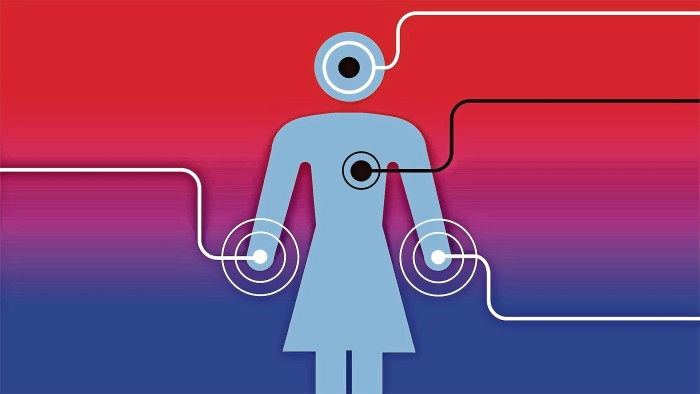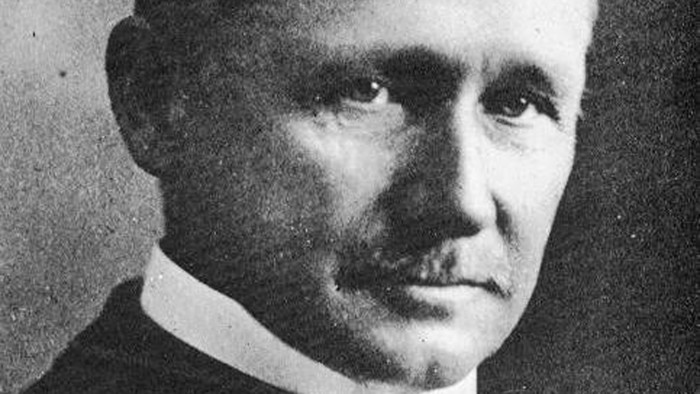Wearables at work: the new frontier of employee surveillance

Roula Khalaf, Editor of the FT, selects her favourite stories in this weekly newsletter.
He only had himself to blame, Mike Weston thought ruefully as he strapped a Fitbit to his wrist one cold February morning. His company was about to start tracking him 24 hours a day, gathering data on everything from his sleep quality and heart rate to his location and web browsing habits.
“I was really quite grumpy about it, I didn’t want to put myself on display like that,” he says. But as chief executive of Profusion, a data science consultancy, he had been urging his team of number crunchers to plan more ambitious internal projects — and this was the one they had come up with.
For 10 days, Profusion’s data scientists used Fitbits and other apps to track 171 personal metrics for 31 staff who volunteered (including the somewhat reluctant Mr Weston). Combing through the data, the analysts found they could group the staff into clusters, based on shared patterns of behaviour. They labelled one group “Busy and Coping”; another “Irritated and Unsettled”.
Technology has made it possible for employers to monitor employees more closely than ever, from GPS trackers for delivery drivers to software that tracks which websites office workers visit. Companies such as Profusion think wearable gadgets could open a new frontier in workplace analytics, albeit one that would further blur the lines between our work and private lives.
“I think there’s an inevitability that it will gain ground, and there’s a backlash risk that will follow if the data get abused,” says Mr Weston.
For employers, the simplest way to use wearable gadgets (and so far the most common) is to give them to staff and try to nudge them into healthier lifestyles — a financially worthwhile goal if the company is on the hook for their health insurance. BP, for example, gives Fitbits to workers in North America and offers them rewards if they meet activity targets. Indeed, one of Fitbit’s five strategic goals is to “further penetrate the corporate wellness market”, according to its IPO prospectus. Wearables could also be straightforward tools.
But the bigger prize is to use the data from such devices to make the workforce safer or more productive. Some warehouse workers already wear wristbands or headsets that measure their productivity and location in real-time.
Kronos, the “workforce management” company whose customers include Apple, Starbucks and Ikea, makes annual revenues of more than $1bn by selling scheduling and real-time data tools that minimise salary bills and maximise productivity. Brenda Morris, who runs Kronos’s UK business, says the company sees applications for wearables in blue and white collar work.
“If you’re monitoring where people are, what their stress levels are, what their fatigue levels are . . .[that’s] really important when operating machinery . . . Or [in an office] you can see that person’s getting stressed because they’ve been working on that legal contract for too many hours and they don’t have enough support.”
Andrew Hill on management
Hand data to employees to make wearable tech bearable at work

Frederick Winslow Taylor is the ghost in the room at debates about new ways of monitoring staff. As the pioneer of “scientific management”, he was the man with a clipboard and stopwatch timing factory workers at the turn of the last century.
Continue reading
Chris Brauer, a senior lecturer at Goldsmiths, University of London, who runs experiments with wearables in workplaces, predicts a future in which managers have dashboards that display real-time employee biometrics such as sleep quality that are leading indicators for performance. “It becomes a predictive tool and possibly also a prescriptive one.”
But that vision is a long way off — and there are a number of practical, legal and ethical hurdles in the way.
First, no one seems to have worked out yet how to analyse or draw useful conclusions from wearables data. Profusion plans to do more trials in larger companies, overlaying the personal metrics with workplace performance data. But so far, the experience of Rob Symes, co-founder of a London start-up called The Outside View, is typical. He tracked all his employees with wearables last year, only to realise: “Right, I’ve got all this data, what the hell does it mean?”
Meanwhile, wearable devices crossing over corporate “digital perimeters” every day are an obvious target for hackers, says Dave Palmer, who spent 13 years at GCHQ and MI5 before joining cyber security company Darktrace as head of technology. “You might think that’s a bit alarmist — what are the chances of my watch or heartrate monitor getting hacked — but this idea of the ‘internet of things’ is racing farther ahead in terms of functionality than in terms of security.”
Wired-up reporting
Quantified journalist experiment

As I worked on this story, I wondered how this technology — if it did take off at work — would affect the way people felt about their jobs and lives. So I tried it out, writes Sarah O’Connor.
Chris Brauer at Goldsmiths, University of London, set me up with some of the wearables he uses in his experiments, from a sleep and activity monitor (Misfit) to a “mood ring” that says it measures emotional intensity (Moodmetric).
I vowed to show the data they generated to my boss after the trial.
It was a strange week. Like most people, I tend to worry about whether I’m doing a good job, but suddenly I had new things to fret about. Would my managers think I was sleeping enough? Too much? Should I go for a jog or sleep an extra hour? Unlike normal work worries, I couldn’t leave these behind at the office.
Read more about the trial at: facebook.com/wearablesatwork
The gadgets are also easy to game. Adam Miller’s employer gives him cash rewards if his Fitbit shows he has taken a certain number of steps a day. But it registers “steps” when jolted, so if he has not met his daily target, “I might watch TV and wave my arm around . . . or my kids will grab it and start shaking it to see what the numbers get to.”
For Dane Atkinson, chief executive of tech company Sumall, this highlights a serious problem with workplace metrics. “It has a law of physics — as soon as people know it’s being observed it changes the outcome.” His solution as a young CEO was to come up with a secret metric his employees did not know about: he tracked the volume and length of their work emails, which he found a surprisingly good indicator of who was in “professional distress”.
“I was struggling with empathy . . . the data really helped me catch up,” he says. “In watching those patterns I could start a conversation and say, hey, what’s going on, and there was almost always a huge unload.”
He thinks it is reasonable for an employer to monitor work emails, “but there’s a moral line that’s not been navigated by public conversation yet”.
The legal line has not been navigated yet, either. Lawyers say companies would have to gain the explicit informed consent of employees before gathering personal data from wearables — and further consent to correlate it with other data, such as performance metrics.
Even then, there is a risk employees would feel implicit pressure to agree, says Daniel Cooper, head of the data privacy team at the law firm Covington.
“Historically European regulators in the data protection area have been very sceptical you can ever get a valid employee consent — they feel that for existing employees, [the relationship] is almost inherently coercive.”
How many workers would say yes, uncoerced, and under what conditions? PwC asked 2,000 people recently: 40 per cent said they would wear a workplace wearable, rising to just over half if they knew it would be used to improve their wellbeing at work.
Employers and employees might share the same goals (less stress in the workplace, say) but then again, they might not. Many of those who said “no way” did not trust their employer not to use the data against them. A promise to anonymise the data and only analyse them in aggregated form would help win people over, PwC found.
For Mike Weston of Profusion, the reaction of his staff to their wearables experiment was as interesting as the data it produced. Some found it enlightening and useful, while others found it “quite disturbing.” One ended up “the most stressed I’ve ever seen her”.
As for him? “I still don’t know if I love it, but I haven’t taken it off.”
Comments